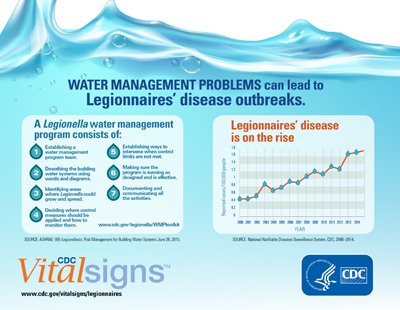Better water system maintenance needed to prevent Legionnaires' disease outbreaks
New toolkit offers practical tips for reducing germ’s growth, spread in building water systems
More effective water management might have prevented most of the Legionnaires’ disease outbreaks CDC investigated from 2000 through 2014, according to CDC Vital Signs report.

Water Management problems can lead to Legionnaires' disease outbreaks
Problems identified in these building-associated outbreaks included inadequate disinfectant levels, human error, and equipment breakdowns that led to growth of Legionella bacteria in water systems. CDC is releasing a new toolkit today to help building owner and managers prevent these problems.
Legionnaires’ disease is on the rise. In the last year, about 5,000 people were diagnosed with Legionnaires’ disease and more than 20 outbreaks were reported to CDC. Legionnaires’ disease is a serious type of lung infection (pneumonia) that people can get by breathing in small droplets of water contaminated with Legionella. Most people who get sick need hospital care and make a full recovery— but about 1 in 10 people will die from the infection.
“Many of the Legionnaire’s disease outbreaks in the United States over the past 15 years could have been prevented,” said expert. "Better water system management is the best way to reduce illness and save lives, and report promotes tools to make that happen."
The Vital Signs report examined 27 building-associated Legionnaires’ disease outbreaks investigated by CDC across 24 states and territories, Mexico, and Canada. For each outbreak, CDC researchers recorded the location, source of exposure, and deficiencies in environmental control of Legionella.
The most common source of building-associated Legionnaires’ disease outbreaks was drinkable water (56 percent), such as water used for showering, followed by cooling towers (22 percent), and hot tubs (7 percent). Other sources included industrial equipment (4 percent) and a decorative fountain/water feature (4 percent). In two outbreaks, the source was never identified.
Twenty-three of the investigations included descriptions of failures that contributed to the outbreak. In nearly half, more than one type of failure was identified.
•About 2 in 3 (65 percent) were due to process failures, like not having a Legionella water management program.
•About 1 in 2 (52 percent) were due to human error, such as a hot tub filter not being cleaned or replaced as recommended by the manufacturer.
•About 1 in 3 (35 percent) were due to equipment, such as a disinfection system, not working.
•About 1 in 3 (35 percent) were due to changes in water quality from reasons external to the building itself, like nearby construction.
Source: U.S. Centers for Disease Control and Prevention
- 294 reads
Human Rights
Ringing FOWPAL’s Peace Bell for the World:Nobel Peace Prize Laureates’ Visions and Actions

Protecting the World’s Cultural Diversity for a Sustainable Future

The Peace Bell Resonates at the 27th Eurasian Economic Summit

Declaration of World Day of the Power of Hope Endorsed by People in 158 Nations

Puppet Show I International Friendship Day 2020

